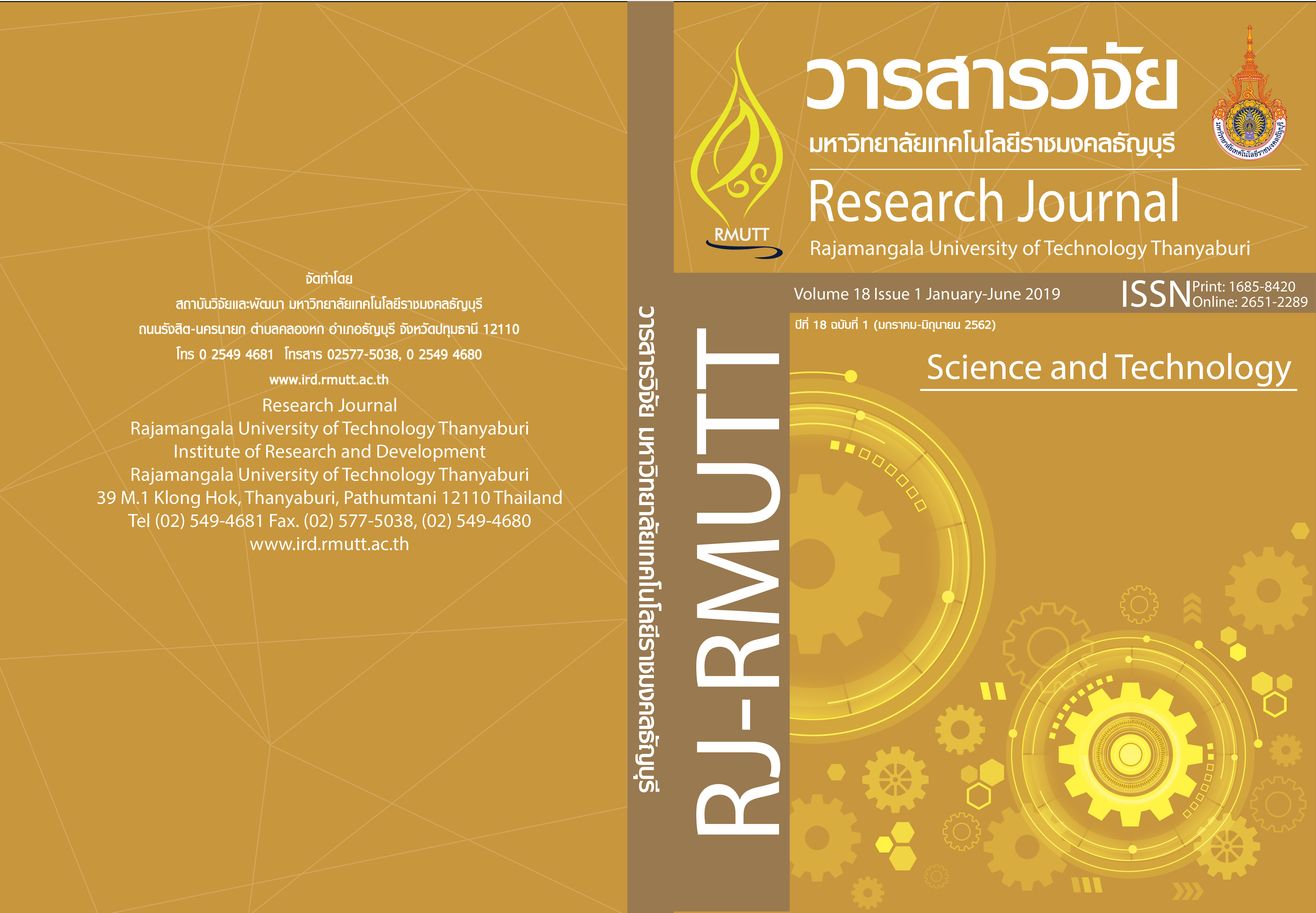Photoelectrocatalytic Oxygen Production from Water Splitting using WO3 Photoanode Fabricated by Dip Coating Technique
Main Article Content
Abstract
This research has developed tungsten oxide (WO3) anode electrode fabrication to enhance photoelectrocatalytic water oxidation property. The WO3 thin film was fabricated on a conducting glass fluorine doped tin oxide (FTO) substrate by a simple dip coating method. The photoelectrocatalytic property was studied by measuring the photocurrent from water oxidation reaction at an applied potential of 1 V in NaCl electrolyte solution under visible light irradiation. Moreover, the catalytic mechanisms at the electrode surface were studied with the mechanism of photocatalytic (PC), electrocatalytic (EC), and photoelectrocatalytic (PEC) by comparing the dissolved oxygen (DO) value in water. The result found that the dipping times are the main effect with the photoelectrocatalytic property of the fabricated WO3 by dip coating technique and found that at 15 min is the optimized condition. It was found that the PEC mechanism presents a higher efficiency for oxygen production than EC and PC mechanism, respectively. The research shows that this introduced dip coating method can fabricate the WO3 thin film for high-efficiency oxygen evolution with the simple method and suitable for further scaling up application.
Article Details

This work is licensed under a Creative Commons Attribution-NonCommercial-NoDerivatives 4.0 International License.
References
Lianos P. Review of recent trends in photoelectrocatalytic conversion of solar energy to electricity and hydrogen. Applied Catalysis B: Environmental. 2017;210:235-54.
Patel M, Park WH, Ray A, Kim J, Lee JH. Photoelectrocatalytic sea water splitting using Kirkendall diffusion grown functional Co3O4 film. Sol Energ Mat Sol C. 2017;171:267-74.
Seferlis AK, Neophytides SG. On the kinetics of photoelectrocatalytic water splitting on nanocrystalline TiO2films. Applied Catalysis B: Environmental. 2013;132-133:543-52.
Monfort O, Pop LC, Sfaelou S, Plecenik T, Roch T, Dracopoulos V, et al. Photoelectrocatalytic hydrogen production by water splitting using BiVO4 photoanodes. Chem Eng J. 2016;286:91-7.
Chen YC, Wu ZJ, Hsu YK. Buffer effect of In2O3 interlayer on band offset at CuO/ZnO interface for enhanced photoelectrocatalytic water splitting. Journal of Catalysis. 2019;370:224-31.
Chen X, Shen S, Guo L, Mao SS. Semiconductor-based Photocatalytic Hydrogen Generation. Chem Rev. 2010;110(11):6503-570.
Fujishima A, Honda K. Electrochemical Photolysis of Water at a Semiconductor Electrode. Nature. 1972;238(5358):37-8.
Cheng X, Zhang Y, Bi Y. Spatial dual-electric fields for highly enhanced the solar water splitting of TiO2 nanotube arrays. Nano Energy. 2019;57:542-8.
Tayebi M, Lee BK. Recent advances in BiVO4 semiconductor materials for hydrogen production using photoelectrochemical water splitting. Renewable and Sustainable Energy Reviews. 2019;111:332-43.
Zhou S, Yue P, Huang J, Wang L, She H, Wang Q. High-performance photoelectrochemical water splitting of BiVO4@Co-MIm prepared by a facile in-situ deposition method. Chem Eng J. 2019;371:885-92.
Bai S, Chu H, Xiang X, Luo R, He J, Chen A. Fabricating of Fe2O3/BiVO4 heterojunction based photoanode modified with NiFe-LDH nanosheets for efficient solar water splitting. Chem Eng J. 2018;350:148-56.
Guo L, Li J, Lei N, Song Q, Liang Z. Morphological evolution and enhanced photoelectrochemical performance of V4+ self-doped, [010] oriented BiVO4 for water splitting. J Alloy Compd. 2019;771:914-23.
Bemana H, Rashid-Nadimi S. Incorporation of NiO electrocatalyst with α-Fe2O3 photocatalyst for enhanced and stable photoelectrochemical water splitting. Surfaces and Interfaces. 2019;14:184-91.
Nasiri M, Sangpour P, Yousefzadeh S, Bagheri M. Elevated temperature annealed α- Fe2O3/reduced graphene oxide nanocomposite photoanode for photoelectrochemical water oxidation. Journal of Environmental Chemical Engineering. 2019;7(2):102999.
Lervolino G, Tantis I, Sygellou L, Vaiano V, Sannino D, Lianos P. Photocurrent increase by metal modification of Fe2O3 photoanodes and its effect on photoelectrocatalytic hydrogen production by degradation of organic substances. Appl Surf Sci. 2017;400:176-83.
Chatchai P, Murakami Y, Kishioka SY, Nosaka AY, Nosaka Y. Efficient photocatalytic activity of water oxidation over WO3/BiVO4 composite under visible light irradiation. Electrochim Acta. 2009;54(3):1147-52.
Soltani T, Tayyebi A, Lee BK. Sonochemical-driven ultrafast facile synthesis of WO3 nanoplates with controllable morphology and oxygen vacancies for efficient photoelectrochemical water splitting. Ultrason Sonochem. 2019;50:230-8.
Soltani T, Tayyebi A, Hong H, Mirfasih MH, Lee BK. A novel growth control of nanoplates WO3 photoanodes with dual oxygen and tungsten vacancies for efficient photoelectrochemical water splitting performance. Sol Energ Mat Sol C. 2019;191:39-49.
Yu SQ, Ling YH, Zhang J, Qin F, Zhang ZJ. Efficient photoelectrochemical water splitting and impedance analysis of WO3−x nanoflake electrodes. Int J Hydrogen Energ. 2017;42(32):20879-87.
Fan X, Gao B, Wang T, Huang X, Gong H, Xue H, et al. Layered double hydroxide modified WO3nanorod arrays for enhanced photoelectrochemical water splitting. Applied Catalysis A: General. 2016;528:52-8.
Chatchai P, Nosaka AY, Nosaka Y. Photoelectrocatalytic performance of WO3/BiVO4 toward the dye degradation. Electrochim Acta. 2013;94:314-9.
Chatchai P, Kishioka SY, Murakami Y, Nosaka AY, Nosaka Y. Enhanced photoelectrocatalytic activity of FTO/WO3/BiVO4 electrode modified with gold nanoparticles for water oxidation under visible light irradiation. Electrochim Acta. 2010;55(3):592-6.
Ferrari VC, Dupim IS, Sousa V, Souza FL. Photoactive multilayer WO3 electrode synthesized via dip-coating. Ceram Int. 2018;44(18):22983-90.
Daghrir R, Drogui P, Robert D. Photoelectrocatalytic technologies for environmental applications. Journal of Photochemistry and Photobiology A: Chemistry. 2012;238:41-52.
Cong Y, Ji Y, Ge Y, Jin H, Zhang Y, Wang Q. Fabrication of 3D Bi2O3-BiOI heterojunction by a simple dipping method: Highly enhanced visible-light photoelectrocatalytic activity. Chem Eng J. 2017;307:572-82.
Pablos C, Marugán J, Adán C, Osuna M, van Grieken R. Performance of TiO2 photoanodes toward oxidation of methanol and E. coli inactivation in water in a scaled-up photoelectrocatalytic reactor. Electrochim Acta. 2017;258:599-606.


